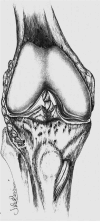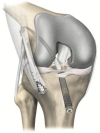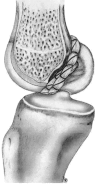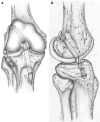Over-The-Top Technique for ACL Reconstruction: Advantages, Disadvantages, and Postoperative Complications
- PMID: 39894764
- PMCID: PMC11787975
- DOI: 10.1111/os.14328
Over-The-Top Technique for ACL Reconstruction: Advantages, Disadvantages, and Postoperative Complications
Abstract
Anterior cruciate ligament (ACL) injuries are the most common knee joint injuries related to sports activities in clinical practice. For treating ACL injuries, anatomical reconstruction surgery is often the preferred method. The over-the-top (OTT) technique is a surgical approach that eliminates the need for creating a femoral tunnel. According to the existing literature, the OTT technique offers distinct advantages, particularly for skeletally immature individuals and in revision cases. Currently, femoral tunnel failure is the most common cause of ACL reconstruction failure, which can lead to less than optimal postoperative performance of the ACL and a higher likelihood of needing a revision. Additionally, mistakes in the placement of the femoral tunnel and the subsequent risk of tunnel enlargement can increase the complexity of revision procedures, ultimately reducing the long-term clinical effectiveness for patients. In contrast, the OTT technique has shown excellent biomechanical performance, avoids the need for bone tunnels, is economically practical, and has been proven to provide satisfactory therapeutic outcomes both in the short and long term, especially for skeletally immature individuals and in revision cases. The OTT technique is deemed a safe and effective surgical method for treating ACL injuries. In summary, the OTT technique has unique benefits for skeletally immature individuals and in revision cases, making it a viable option worth considering. Level of evidence V.
Keywords: advantages; anterior cruciate ligament reconstruction (ACLR); complication; disadvantages; over‐the‐top (OTT).
© 2024 The Author(s). Orthopaedic Surgery published by Tianjin Hospital and John Wiley & Sons Australia, Ltd.
Conflict of interest statement
The authors declare no conflicts of interest.
Figures








Similar articles
-
Over-the-top ACL reconstruction restores anterior and rotatory knee laxity in skeletally immature individuals and revision settings.Knee Surg Sports Traumatol Arthrosc. 2020 Feb;28(2):538-543. doi: 10.1007/s00167-019-05719-5. Epub 2019 Sep 23. Knee Surg Sports Traumatol Arthrosc. 2020. PMID: 31549207
-
Outcomes Following Primary Anterior Cruciate Ligament Reconstruction Using a Partial Transphyseal (Over-the-Top) Technique in Skeletally Immature Patients.Iowa Orthop J. 2022 Jun;42(1):179-186. Iowa Orthop J. 2022. PMID: 35821916 Free PMC article.
-
Anterior cruciate ligament femoral side retained stump technique reduces enlargement of the femoral bone tunnel after anterior cruciate ligament reconstruction.BMC Musculoskelet Disord. 2024 May 14;25(1):380. doi: 10.1186/s12891-024-07464-4. BMC Musculoskelet Disord. 2024. PMID: 38745214 Free PMC article.
-
Over-the-top ACL reconstruction yields comparable outcomes to traditional ACL reconstruction in primary and revision settings: a systematic review.Knee Surg Sports Traumatol Arthrosc. 2019 Feb;27(2):427-444. doi: 10.1007/s00167-018-5084-2. Epub 2018 Aug 4. Knee Surg Sports Traumatol Arthrosc. 2019. PMID: 30078121
-
[Research progress of femoral bone tunnel positioning in anterior cruciate ligament reconstruction].Zhongguo Xiu Fu Chong Jian Wai Ke Za Zhi. 2024 Apr 15;38(4):498-504. doi: 10.7507/1002-1892.202401121. Zhongguo Xiu Fu Chong Jian Wai Ke Za Zhi. 2024. PMID: 38632073 Free PMC article. Review. Chinese.
Cited by
-
Robotic surgery in healthcare: current challenges, technological advances, and global implementation prospects.J Robot Surg. 2025 Sep 8;19(1):577. doi: 10.1007/s11701-025-02702-w. J Robot Surg. 2025. PMID: 40924241 Review.
References
-
- Steiner M., “Anatomic Single‐Bundle ACL Reconstruction,” Sports Medicine and Arthroscopy Review 17, no. 4 (2009): 247–251. - PubMed
-
- Sroufe M. D., Sumpter A. E., Thompson X. D., et al., “Comparison of Patient‐Reported Outcomes, Strength, and Functional Performance in Primary Versus Revision Anterior Cruciate Ligament Reconstruction,” American Journal of Sports Medicine 51, no. 8 (2023): 2057–2063. - PubMed
-
- Hurley E. T., Fried J. W., Kingery M. T., Strauss E. J., and Alaia M. J., “Antero‐Lateral Ligament Reconstruction Improves Knee Stability Alongside Anterior Cruciate Ligament Reconstruction,” Knee Surgery, Sports Traumatology, Arthroscopy: Official Journal of the ESSKA 29, no. 3 (2021): 764–771. - PubMed
Publication types
MeSH terms
Grants and funding
LinkOut - more resources
Full Text Sources
Medical

